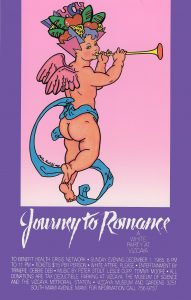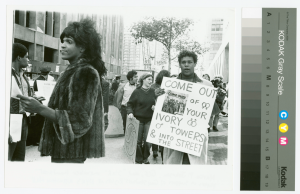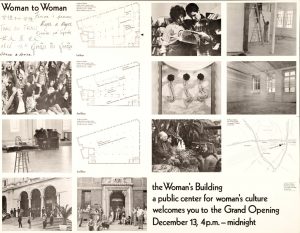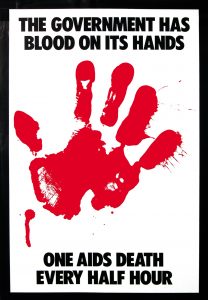The purple painting on display at the Patricia and Phillip Frost Art Museum shows a multicolored cherub blowing a horn, along with the words “Journey to Romance.”
It’s one of more than 200 pieces in the exhibition, “Art After Stonewall: 1969 – 1989” that — taken together — depict a groundbreaking moment in the history of LGBTQ liberation specific to Miami. It was also the poster for the very first White Party at the Vizcaya Museum in 1985.
Artist Martin Kreloff played a vital role alongside organizers Frank Wager and Jorge Suarez in creating the poster that brought 1,600 attendees that night. The party began as a fundraiser for HIV/AIDS research.
 “AIDS in 1985 was not an easy concept to get people to come to a party to raise money,” Kreloff says, “That little cherub was to bring joy, romance, and a light, loving approach. It started something well beyond my wildest dreams and something I’m so proud of. It’s just phenomenal what it did, you know, beyond the drawing.”
“AIDS in 1985 was not an easy concept to get people to come to a party to raise money,” Kreloff says, “That little cherub was to bring joy, romance, and a light, loving approach. It started something well beyond my wildest dreams and something I’m so proud of. It’s just phenomenal what it did, you know, beyond the drawing.”
Kreloff currently lives in Las Vegas, Nevada. With exhibitions like “Miami Says Art” in 1976 and 1978’s “Miami Works,” which highlighted the works of local artists, he strove to make the area an art-fueled destination before Art Basel Miami Beach.
Kreloff says the idea for the White Party artwork came to him several years before he drew it. He had been creating portraits of his friends dressed in white — as the protagonists were described in the famous F. Scott Fitzgerald novel The Great Gatsby — for an annual fundraising event at Vizcaya.
“I put Vizcaya, Gatsby white, hope, joy, and romance together, and I said, ‘Why don’t I have a party where everyone comes in white and we’ll call it Journey to Romance – a White Party at Vizcaya.’ I didn’t know it had become the White Party in the following years,” Kreloff says.
That was 34 years ago. These days, circuit parties, dance gatherings associated with LGBTQ culture, are held annually across the country in large cities. Miami is famous for holding the White Party at Vizcaya, located at 3251 S Miami Ave., where guests dress according to theme, in all-white attire.
Celebrating the 50th anniversary of the Stonewall riots, a pivotal moment in the fight for gay rights, “Art After Stonewall: 1969 – 1989” is the first national exhibit to highlight two decades of the impact of the Lesbian, Gay, Bisexual, Transgender movement in the art world.
The exhibit opened this month at the Patricia & Phillip Frost Art Museum at Florida International University’s Modesto A. Maidique Campus. It is the first time the exhibit is under one roof — it premiered at two locations including the Leslie-Lohman Museum of Gay and Lesbian Art in New York City this past April. The collection was organized by the Columbus Museum of Art and was curated by artist, critic and historian Jonathan Weinberg alongside CMA’s curator of contemporary art, Tyler Cann, Roy Lichtenstein curatorial fellow Daniel Marcus, and Brooklyn Museum’s curator of photography Drew Sawyer.
“It’s a shame there hasn’t really been an exhibition like this, and it brings forth tremendous pressure,” Weinberg says. “If we had many, many exhibits like this, then this exhibit wouldn’t have to be so representational.”
 Weinberg knew Miami would be a good place to bring the exhibition because of an important moment in the history of queer liberation that took place in 1977 — the Florida orange juice boycott. Anita Bryant, a well known singer and beauty queen who was also a gay rights opponent and spokesperson for the Florida orange juice industry, fought to repeal a groundbreaking law that banned discrimination on the basis of sexual orientation. After Miami-Dade Commissioners passed the law, Bryant’s “Save Our Children” campaign convinced citizens to repeal the act. Then local outrage spread nationally. This was the first time LGBTQ discrimination had been widely spread through print and television.
Weinberg knew Miami would be a good place to bring the exhibition because of an important moment in the history of queer liberation that took place in 1977 — the Florida orange juice boycott. Anita Bryant, a well known singer and beauty queen who was also a gay rights opponent and spokesperson for the Florida orange juice industry, fought to repeal a groundbreaking law that banned discrimination on the basis of sexual orientation. After Miami-Dade Commissioners passed the law, Bryant’s “Save Our Children” campaign convinced citizens to repeal the act. Then local outrage spread nationally. This was the first time LGBTQ discrimination had been widely spread through print and television.
Displayed at the exhibit are lapel pins and bumper stickers from the era reading “No More Orange Juice from the Un-Shine State” and an Alive! Magazine cover with a sticker covering Bryant’s mouth including the words, “Vote Against Repeal!”
A sculpture, “Women Love Women” by Nancy Fried, presents a scene of domestic life including two women and is made out of dough – flour, salt, and water. It is painted with acrylic. Fried’s art was featured during the feminist art movement of the 1970s in the Woman’s Building in Los Angeles, California.
Weinberg points out that the exhibit is strictly about the work of the artist, not how the artist identifies. Sexuality or gender are only referenced if the work is solely about that.
“Greer Lankton is an incredible trans artist who made these amazing dolls, and there’s a drawing about her transition,” Weinberg says. “In that instance, we’ll talk about the work being about her transition and about sort of the trauma of that process that she went through.”
 The exhibit also displays a photograph of artist and performer Charles Ludlam getting ready for a performance in drag by photographer Peter Hujar. In 1967, Ludlam founded the Ridiculous Theatrical Company, which spoofed existing works in gender-bending fashion. A poster for one of his plays can be found next to his photograph.
The exhibit also displays a photograph of artist and performer Charles Ludlam getting ready for a performance in drag by photographer Peter Hujar. In 1967, Ludlam founded the Ridiculous Theatrical Company, which spoofed existing works in gender-bending fashion. A poster for one of his plays can be found next to his photograph.
Four costumed puppets from shows Ludlam constructed for children are also on display at the exhibit.
Ludlam is one of the many artists in the exhibition who passed away from HIV/AIDS. Weinberg says it is important to represent artists who would have been alive today if it weren’t for the epidemic and to acknowledge oft-ignored older artists.
“Someone asked me a few weeks ago, ‘How is this show a response to the community?’ I said, ‘Actually, it’s not for any particular community, it’s for everybody,’” Weinberg says.
He hopes that when young people see works like this that it’s affirming because so much of the work is about resisting injustice.
 “The section of art about AIDS has these great posters designed by Gran Fury that were a response to the government inaction about the disease when Ronald Reagan, wouldn’t even say the word ‘AIDS’,” Weinberg says. “There are so many ways in which people got together to not only fight government in action, but to make sure that drugs could be tested and used more quickly or insist that if drugs were created to treat HIV that they’d be affordable and accessible.”
“The section of art about AIDS has these great posters designed by Gran Fury that were a response to the government inaction about the disease when Ronald Reagan, wouldn’t even say the word ‘AIDS’,” Weinberg says. “There are so many ways in which people got together to not only fight government in action, but to make sure that drugs could be tested and used more quickly or insist that if drugs were created to treat HIV that they’d be affordable and accessible.”
Art After Stonewall: 1969 – 1989 will be on view in Miami through Jan. 5, 2020 and the exhibit will travel to the Columbus Museum of Art, Ohio on March 6 through May 31, 2020.

































